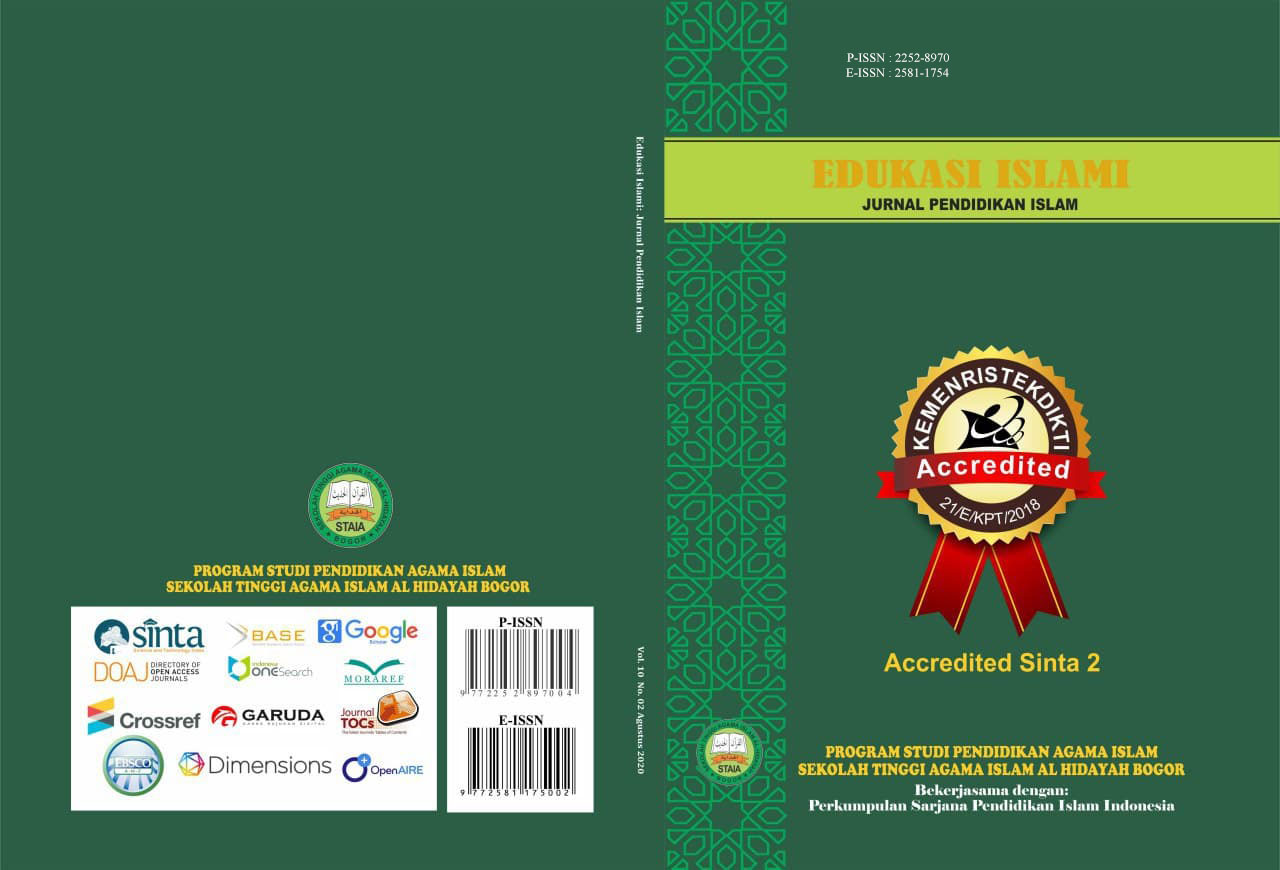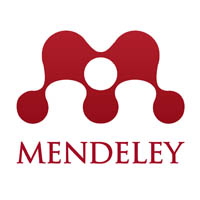Kebijakan Komunikasi Muhammadiyah Sumatera Utara Pada Pemilu 2019 dan Pengaruhnya di Dunia Pendidikan Islam
DOI:
https://doi.org/10.30868/ei.v11i01.2840Keywords:
Kebijakan Komunikasi, Muhammadiyah, Pemilihan Umum.Abstract
Surat instruksi yang dikeluarkan oleh Pimpinan Wilayah Muhammadiyah (PWM) Sumatera Utara terkait penentuan sikap politik pada satu calon anggota DPD RI pada pemilu tahun 2019 dalam menyikapi dinamika politik tahun 2019 telah menimbulkan pro kontra bagi anggota dan simpatisan Muhammadiyah Sumatera Utara dalam menyikapi nya. Penelitian ini bertujuan untuk menganalisa kebijakan komunikasi PWM Sumut dalam menyikapi pemilu DPD RI tahun 2019 yang berasal dari Propinsi Sumatera Utara. Penelitian ini merupakan penelitian kualitatif dengan pendekatan studi deskriptif. Informan dalam penelitian ini menggunakan teknik judgement sampling yaitu narasumber yang telah ditetapkan berdasarkan kebutuhan. Analisis dilakukan dengan mereduksi data, menyajikan data dan melakukan verifikasi terhadap data yang ada. Hasil penelitian menemukan bahwa Kebijakan komunikasi PWM Sumut merupakan bagian dari ijtihad politik Muhammadiyah secara transparan dan tetap memberikan kebebasan (sebagai panduan) bagi anggota dan simpatisan Muhammadiyah dalam menentukan sikap politiknya
References
Adhani, A., Anshori, A., & Mahardika, A. (2022). Public Attitudes towards the Government’s Policy Communication in Preventing COVID-19. Jurnal ASPIKOM, 7(1), 61. https://doi.org/10.24329/aspikom.v7i1.1058
Al-Hamdi, R. (2012). Dinamika Islam Dan Politik Elit - Elit Muhammadiyah Periode 1998-2010. Journal of Government and Politics, 3(1), 161–196. https://doi.org/10.18196/jgp.2012.0009
Aritonang, A. I. (2011). Kebijakan Komunikasi di Indonesia: Gambaran Implementasi UU No. 14 tahun 2008 tentang Keterbukaan Informasi Publik. Jurnal ASPIKOM, 1(3), 261. https://doi.org/10.24329/aspikom.v1i3.24
Born, A., van Eck, P., & Johannesson, M. (2018). An Experimental Investigation of Election Promises. Political Psychology, 39(3), 685–705. https://doi.org/10.1111/pops.12429
Botha, E. (2014). A means to an end: Using political satire to go viral. Public Relations Review, 40(2), 363–374. https://doi.org/10.1016/j.pubrev.2013.11.023
Bucăţa, G., & Rizescu, A. M. (2017). The Role of Communication in Enhancing Work Effectiveness of an Organization. Land Forces Academy Review, 22(1), 49–57. https://doi.org/10.1515/raft-2017-0008
Chou, H., & Yeh, M. (2017). Minor Language Variations in Campaign Advertisements : The Effects of Pronoun Use and Message Orientation on Voter Responses. Electoral Studies, August, 0–1. https://doi.org/10.1016/j.electstud.2017.10.006
Creswell, J. W. (2014). Research Design: Qualitative, Quantitative, and Mixed Methods Approaches. London: Sage Publications.
D’Acunto, F., Hoang, D., Paloviita, M., & Weber, M. (2020). Effective Policy Communication: Targets Versus Instruments. SSRN Electronic Journal, October, 20–38. https://doi.org/10.2139/ssrn.3764722
Dupont, J. C., Bytzek, E., Steffens, M. C., & Schneider, F. M. (2019). Which Kind of Political Campaign Messages Do People Perceive as Election Pledges? Electoral Studies, 57, 121–130. https://doi.org/10.1016/j.electstud.2018.11.005
Green, D. P., & Schwam-Baird, M. (2016). Mobilization, Participation, and American Democracy: A Retrospective and Postscript. Party Politics, 22(2), 158–164. https://doi.org/10.1177/1354068815605678
Gurevitch, M., Coleman, S., & Blumler, J. G. (2009). Political Communication -Old and New Media Relationships. Annals of the American Academy of Political and Social Science, 625(1), 164–181. https://doi.org/10.1177/0002716209339345
Malaval, P., Bénaroya, C., & Aflalo, J. (2014). Communication Policy. 363–386. https://doi.org/10.1007/978-3-319-01354-1_11
Masduki, A., & Widyatama, R. (2018). Efektifitas Strategi Komunikasi Politik Elit Muhammadiyah DIY Dalam Pemenangan Pemilu DPD-RI. Communicare: Journal of Communication Studies, 5(1), 1–18.
Miftakhuddin. (2020). Manajemen Organisasi Dakwah Islam. An-Nida’ : Jurnal Prodi Komunikasi Penyiaran Islam, VIII(1), 1–24.
Miles, M. B., & Huberman, A. M. (1992). Analisis Data Kualitatif: Buku Sumber Tentang Metode-metode Baru. Jakarta: Universitas Indonesia.
Naurin, E. (2014). Is A Promise A Promise? Election Pledge Fulfilment in Comparative Perspective Using Sweden as An Example. West European Politics, 37(5), 1046–1064. https://doi.org/10.1080/01402382.2013.863518
Nawi, R. (2015). Implementation of the Communication Policy of the Organization of Government in Indonesia. Journal of Humanity, 3(1), 28–41. https://doi.org/10.14724/03.04
Purnomo, A. (2018). Pelaksanaan Kebijakan Komunikasi Organisasi Pemerintahan di Indonesia. Jurnal Noken, 3(2), 11–26.
Rubino, Hatta, M., & Abdullah. (2017). Communication Technique of Hizbut Tahrir Indonesia (HTI) In the Development of Cadre in North Sumatera. International Journal on Language, Research and Education Studies, 1(2), 240–255.
Schermann, K., & Ennser-Jedenastik, L. (2014). Coalition Policy-Making under Constraints: Examining the Role of Preferences and Institutions. West European Politics, 37(3), 564–583. https://doi.org/10.1080/01402382.2013.841069
Schuck, A. R. T., Vliegenthart, R., & De Vreese, C. H. (2014). Who’s Afraid of Conflict? The Mobilizing Effect of Conflict Framing in Campaign News. British Journal of Political Science, 46(1), 177–194. https://doi.org/10.1017/S0007123413000525
Sokolovska, N., Fecher, B., & Wagner, G. G. (2019). Communication on the Science-Policy Interface: An Overview of Conceptual Models. Publications, 7(64), 1–15. https://doi.org/10.3390/publications7040064
Sugiyono. (2017). Metode Penelitian Kuantitatif, Kualitatif, dan R&D. Bandung: Alfabeta.
Thomson, R. (2011). Citizens’ Evaluations of the Fulfillment of Election Pledges: Evidence from Ireland. Journal of Politics, 73(1), 187–201. https://doi.org/10.1017/S0022381610000952
Thomson, R., & Brandenburg, H. (2019). Trust and Citizens’ Evaluations of Promise Keeping by Governing Parties. Political Studies, 67(1), 249–266. https://doi.org/10.1177/0032321718764177
Vardavas, C., Odani, S., Nikitara, K., El Banhawi, H., Kyriakos, C., Taylor, L., & Becuwe, N. (2021). Public perspective on the governmental response, communication and trust in the governmental decisions in mitigating COVID-19 early in the pandemic across the G7 countries. Preventive Medicine Reports, 21, 101252. https://doi.org/10.1016/j.pmedr.2020.101252
Yildirim, O. (2014). The Impact of Organizational Communication on Organizational Citizenship Behavior: Research Findings. Procedia - Social and Behavioral Sciences, 150, 1095–1100. https://doi.org/10.1016/j.sbspro.2014.09.124
Pia Khoirotun Nisa. (2015). Karakteristik Budaya Komunikasi Politik Elit Muhammadiyah. Al Amin: Jurnal Kajian Ilmu dan Budaya Islam, 3(1).
Mohammad Siddiq, Hartini Salama. (2018). PERAN MUHAMMADIYAH DALAM PENDIDIKAN NASIONAL. Jurnal MUQADDIMAH, 14(3).
Arif Rahman Prasetyo. (2020). Implementation of Character Education Policy in MTs Muhammadiyah Al Manar Demak Regency. Tribakti: Jurnal Pemikiran Keislaman, 31(1).
Farid Setiawan. (2014). Kebijakan Pendidikan Muhammadiyah Terhadap Ordonansi Guru. Jurnal Pendidikan Islam, III(1).
Downloads
Published
Issue
Section
Citation Check
License
Authors who publish with this journal agree to the following terms:
- Authors retain copyright and grant the journal right of first publication with the work simultaneously licensed under a Creative Commons Attribution License that allows others to share the work with an acknowledgment of the work's authorship and initial publication in this journal.
- Authors are able to enter into separate, additional contractual arrangements for the non-exclusive distribution of the journal's published version of the work (e.g., post it to an institutional repository or publish it in a book), with an acknowledgment of its initial publication in this journal.
- Authors are permitted and encouraged to post their work online (e.g., in institutional repositories or on their website) prior to and during the submission process, as it can lead to productive exchanges, as well as earlier and greater citation of published work (See The Effect of Open Access).









